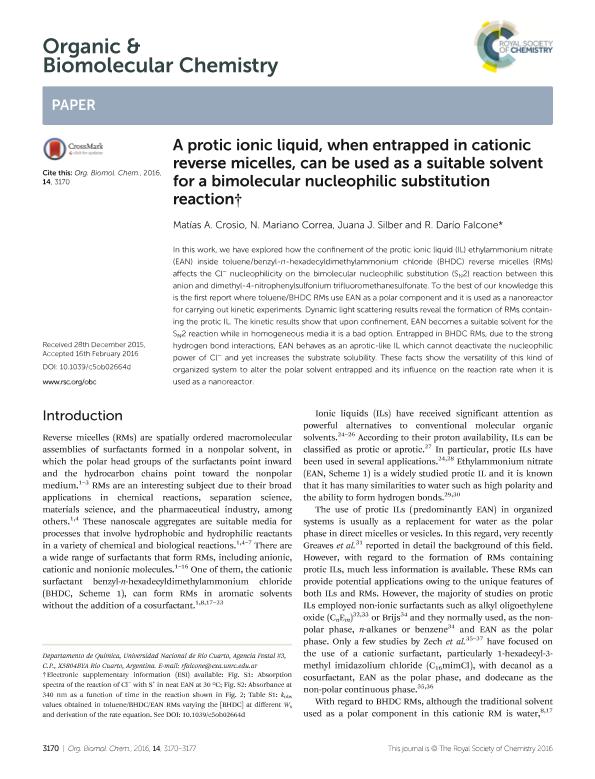Artículo
A protic ionic liquid, when entrapped in cationic reverse micelles, can be used as a suitable solvent for a bimolecular nucleophilic substitution reaction
Fecha de publicación:
02/2016
Editorial:
Royal Society of Chemistry
Revista:
Organic & Biomolecular Chemistry
ISSN:
1477-0520
e-ISSN:
1477-0539
Idioma:
Inglés
Tipo de recurso:
Artículo publicado
Clasificación temática:
Resumen
In this work, we have explored how the confinement of the protic ionic liquid (IL) ethylammonium nitrate (EAN) inside toluene/benzyl-n-hexadecyldimethylammonium chloride (BHDC) reverse micelles (RMs) affects the Cl- nucleophilicity on the bimolecular nucleophilic substitution (SN2) reaction between this anion and dimethyl-4-nitrophenylsulfonium trifluoromethanesulfonate. To the best of our knowledge this is the first report where toluene/BHDC RMs use EAN as a polar component and it is used as a nanoreactor for carrying out kinetic experiments. Dynamic light scattering results reveal the formation of RMs containing the protic IL. The kinetic results show that upon confinement, EAN becomes a suitable solvent for the SN2 reaction while in homogeneous media it is a bad option. Entrapped in BHDC RMs, due to the strong hydrogen bond interactions, EAN behaves as an aprotic-like IL which cannot deactivate the nucleophilic power of Cl- and yet increases the substrate solubility. These facts show the versatility of this kind of organized system to alter the polar solvent entrapped and its influence on the reaction rate when it is used as a nanoreactor.
Archivos asociados
Licencia
Identificadores
Colecciones
Articulos(CCT - CORDOBA)
Articulos de CTRO.CIENTIFICO TECNOL.CONICET - CORDOBA
Articulos de CTRO.CIENTIFICO TECNOL.CONICET - CORDOBA
Citación
Crosio, Matias Ariel; Correa, Nestor Mariano; Silber, Juana J.; Falcone, Ruben Dario; A protic ionic liquid, when entrapped in cationic reverse micelles, can be used as a suitable solvent for a bimolecular nucleophilic substitution reaction; Royal Society of Chemistry; Organic & Biomolecular Chemistry; 14; 11; 2-2016; 3170-3177
Compartir
Altmétricas




